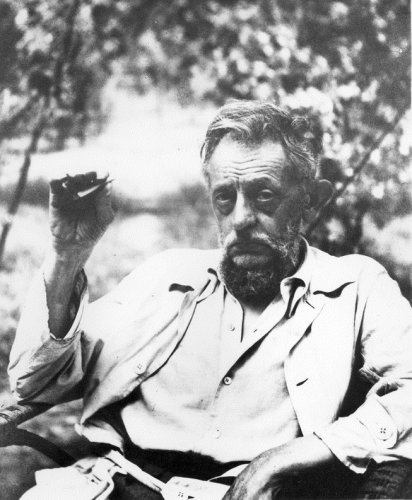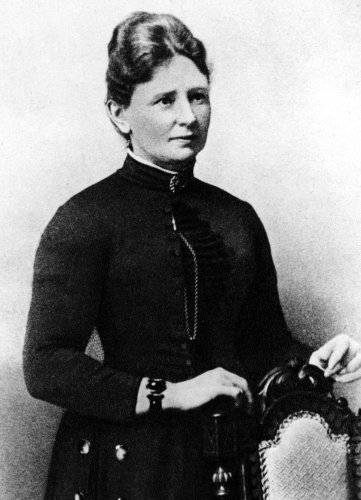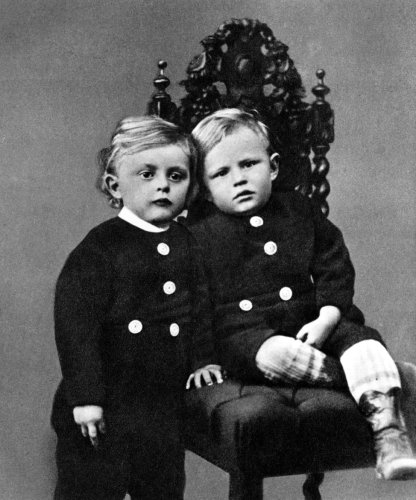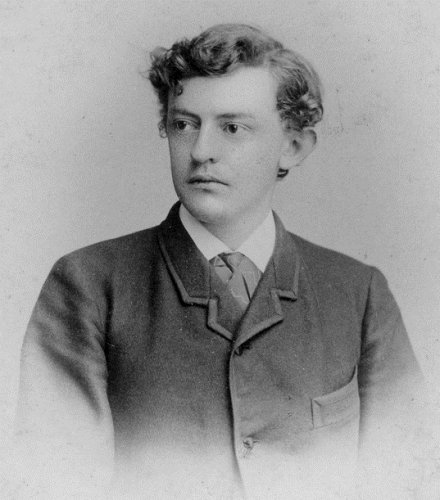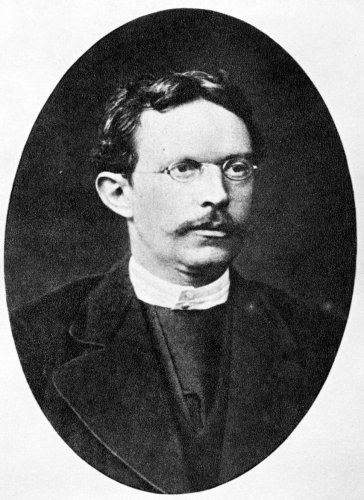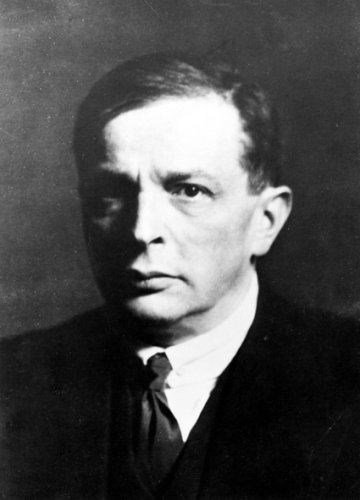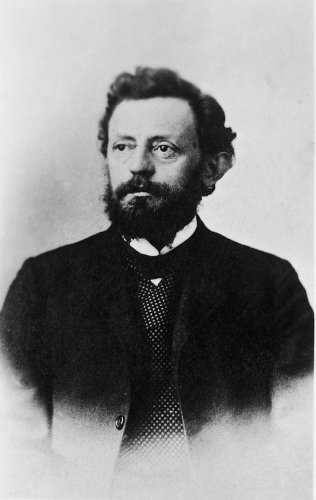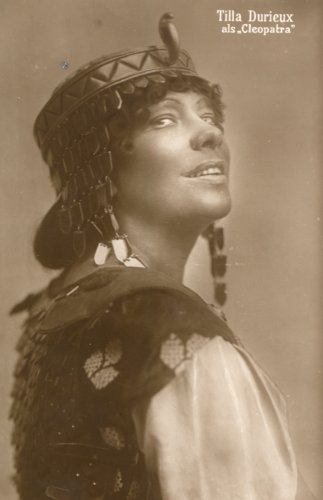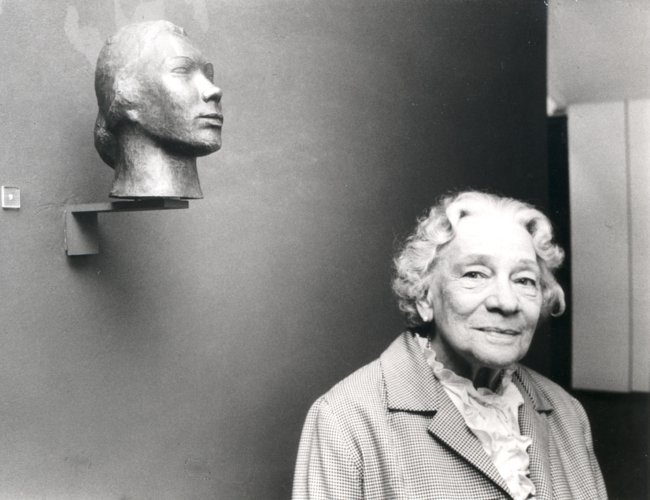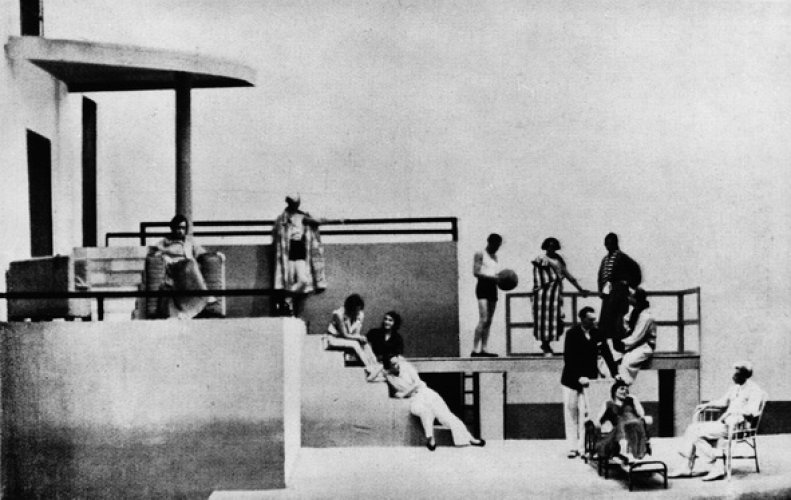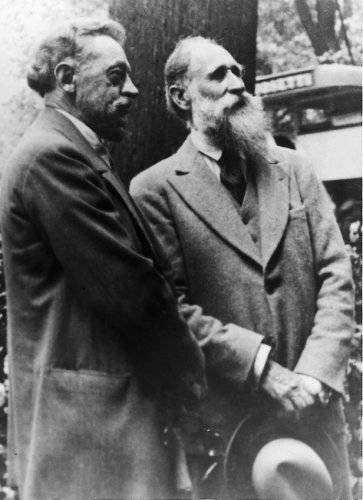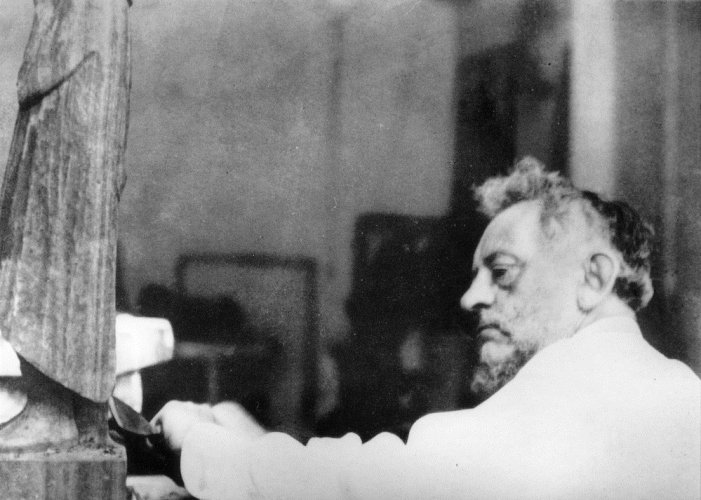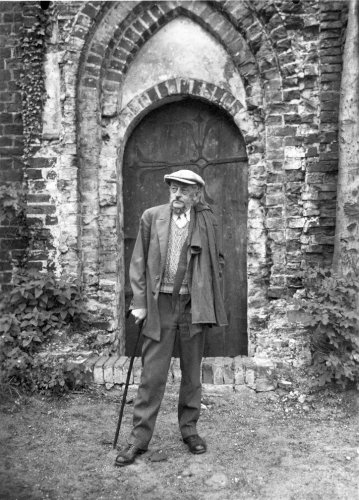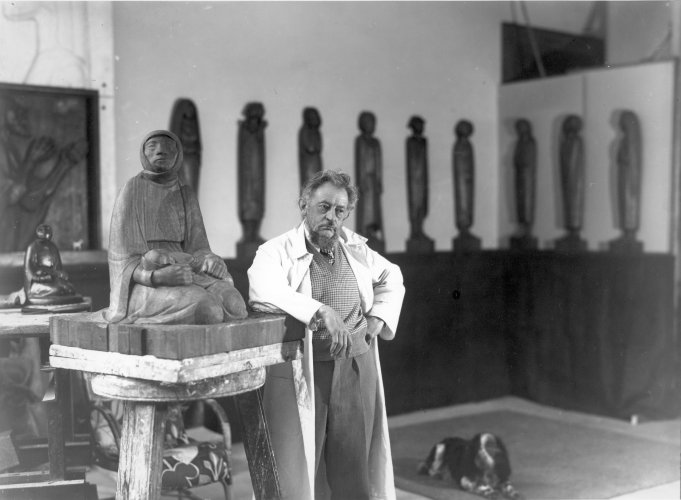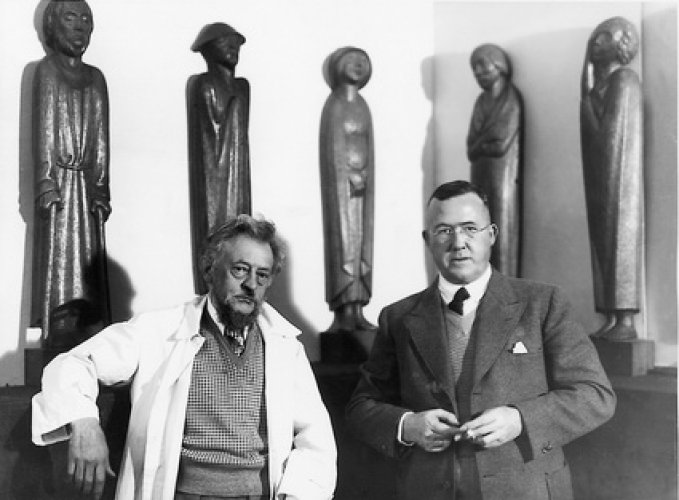Biography as PDF to download
The sculptures marked * in the text are in the collection of the Ernst Barlach Haus.
1870–1887
Ernst Barlach is born on 2 January in Wedel, Holstein, as the first of four sons to the doctor Georg Barlach and his wife Louise, née Vollert. In 1872 the family moves to Schönberg in Mecklenburg, in 1877 to Ratzeburg. After the unexpected death of Georg Barlach in 1884, Louise moves back to Schönberg with her sons. Ernst attends the local secondary school. He becomes friends with Friedrich Düsel. First drawings.
1888–1894
Barlach trains as commercial art teacher at the General Vocational School in Hamburg. He changes to the sculpture class of Theodor Richard Thiele; intensive studies of anatomy, life drawing and garment drawing, together with drawing and modelling according to ancient, Renaissance and Romantic examples. In 1891 Barlach transfers to the Royal Academy of Visual Arts in Dresden. He attends lectures on Greek art by the archaeologist Georg Treu and makes studies in the sculpture collection of the Albertinum. In 1892 he joins the master class of Robert Diez, who rejects late classicism and requires his students to study from nature. in 1893 Barlach illustrates the architectural textbook Figürliches Zeichnen [Representational Drawing]. His graduation piece for the Dresden academy is the sculpture The Herb Gatherer in 1894.
1895
Rue Alain Chartier. Osbert is a central figure among the Parisian symbolists, whose meetings Barlach joins. Barlach studies at the Académie Julian and involves himself with art nouveau and Egyptian art. He writes short prose texts and the novel fragment The Travels of Humour and the Spirit of Observation.
1896–1900
Returns to his mother in Friedrichroda in Thuringia. In 1897 Barlach works with Carl Garbers on the figure Klio for the Mayoral Hall in Hamburg Town Hall, and in 1898 – having moved to Altona in the meantime – on the relief figures on the north tympanum of the New Town Hall in Altona. He does illustrations for the journal Die Jugend [Youth] and produces designs for the Schleswig-Holstein Memorial in Altona. Together with Garbers he wins the competition to redesign the Rathausmarkt square in Hamburg, but is not commissioned. He moves to Berlin in 1899. Designs for sculptures and models for craft objects. In 1900 he is commissioned to design the Moeller-Jarke family tomb in Hamburg. His friendship with the publisher Reinhard Piper begins in the same year.
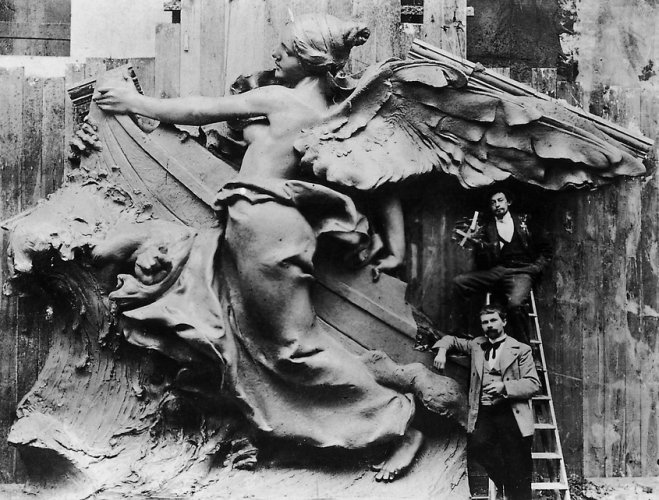
of the New Town Hall in Altona, 1898
1901–1903
Barlach moves to Hamburg. With Garbers he designs a monumental Neptune group for the administrative headquarters of the Hamburg-America Line. Resident in Wedel from 1902. Barlach produces *vases and *jars for the ceramics makers Hermann and Richard Mutz in Altona. He becomes acquainted with Justus Brinckmann, the director of the Hamburg Museum of Arts and Crafts.
1904–1905
Relocation to Höhr in the Westerwald. Barlach temporarily assumes a teaching position in painting, drawing and modelling at the Royal College of Ceramics. Exhibition of *ceramics and drawings in the recently founded Berlin studio of Richard Mutz. Moves to Berlin-Friedenau in 1905. Depression and artistic doubts turn Barlach’s life into a ‘daily hell’. Love affair with Rosa Schwab, who works as a seamstress and model.
1906
Barlach draws caricatures for the magazine Simplicissimus. From 2 August to 27 September he travels with his brother Nikolaus to Southern Russia (today Ukraine) to visit their brother Hans, who is working as a heating engineer in Kharkiv. Stays in Hans’s summerhouse in Pokatilovka, near Kharkiv. Travels to Belgorod and the southern Donets Basin. Barlach receives important impulses for his artistic work through his encounter with Russian peasants and beggars and his experience of the southern Siberian steppes. Rosa Schwab gives birth to a son Nikolaus on 20 August in Berlin.
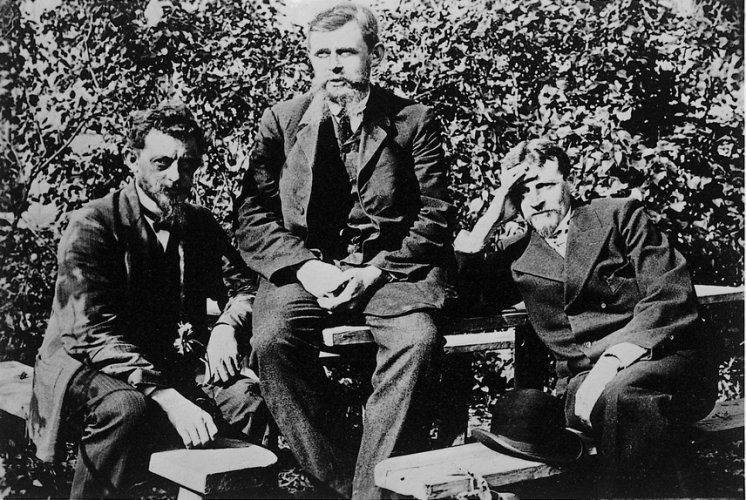
1907
Contact to the gallerist and publisher Paul Cassierer through the sculptor August Gaul. The *Blind Beggar and *Russian Beggar Woman with Bowl are exhibited at the Berlin Secession. Barlach writes his first play, The Dead Day, in which he works through his relationship to his parents, and publishes drawings in Simplicissimus. First sales of his work. Member of the Berlin Secession. Sues Rosa Schwab for custody of Nikolaus, which is granted Barlach in 1908.
1908
A contract with Paul Cassirer guarantees Barlach a livelihood. Intensive preoccupation with the material of wood. From 1907 to 1908 Barlach creates Seated Herdsman, Seated Woman, Reclining Peasant and Shepherd in Storm. Barlach stops working for Simplicissimus.
1909
Scholarship to the Villa Romana in Florence through the recommendation of Cassirer and Max Liebermann. Makes friends with the poet Theodor Däubler, who introduces Barlach to Eastern philosophy and a cosmological view of nature, and together they undertake walking tours of Tuscany. Barlach completes the wooden sculptures Astrologer I and II, Man Counting Money and The Drinker.
1910
Barlach transfers his studio and place of residence to Güstrow. With ten sculptural works he takes part in the first Sonderbund exhibition in Düsseldorf. Special presentation of eight sculptures and twenty drawings within the twenty-first exhibition of the Berlin Secession. Elected onto the executive committee of the Berlin Secession. Creates the wooden sculptures Wayfarer at Rest, *Worried Woman and *The Berserker, and also drawings for The Dead Day and Heinrich von Kleist’s Michael Kohlhaas.
1911
Begins his second play The Poor Cousin. Consideration of the issues raised in Wassily Kandinsky’s On the Spiritual in Art. Creates the wooden sculptures *Three Women Singing, The Lonely Man, *Man Drawing Sword and the relief *Beggar Woman.
1912
Barlach travels with Cassirer and his wife, the actress Tilla Durieux, to their holiday house in Noordwijk in Holland; creation of the portraits Tilla Durieux I, II, *III and *IV. Barlach visits museums in Amsterdam, The Hague and Haarlem and is enthralled by Rembrandt, Bruegel and Grünewald. Publication of the play The Dead Day with twenty-seven lithographs after the drawings of 1910/11. Participates in the second Sonderbund exhibition. Works on Diario Däubler, a literary portrait of Theodor Däubler. Elected once again to the executive committee of the Berlin Secession. Completion of *Woman Dreaming, The Vision, *The Rambler, *The Desert Preacher and Terror.
1913
Barlach works on his autobiographical novel Seespeck. He resigns from the Berlin Secession and becomes a member of the jury for the Free Secession. Travels through Mecklenburg with Theodor Däubler and portrays him in drawings and sculptures. Creation of *The Village Fiddler.
1914–1916
At the outset of the First World War Barlach takes charge of a day-care centre for the children of soldiers. Initial enthusiasm for the war and work for Kriegszeit [Wartime], an artistic pamphlet put out by Cassirer. Creation of the bronze *The Avenger; Barlach completes the *wooden version in 1922. In 1915/16 he trains as a reserve soldier in Sonderburg on the Danish border; a petition from August Gaul and Max Liebermann to the Imperial War Ministry obtains his early exemption. He works through his war experiences in the Güstrow Diary. Contributes to the pacifist publication Der Bildermann [The Picture Man] initiated by Cassirer. Becomes friends with the art teacher Friedrich Schult, who will later prepare the first catalogues raisonnés of Barlach’s work.
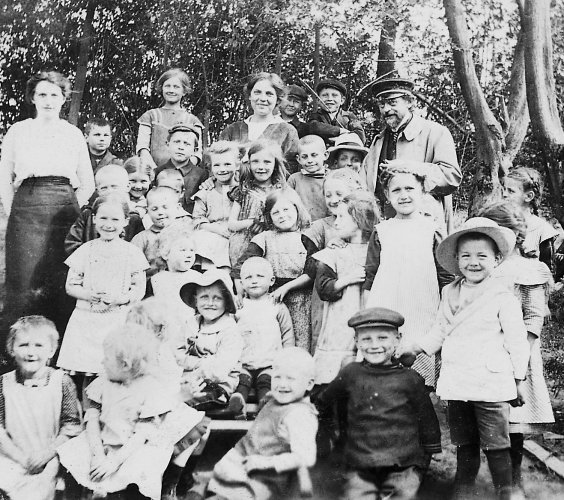
1917
Barlach writes the social drama The Genuine Sedemunds. His first solo exhibition at the Kunstsalon Cassirer, with the lithographs for The Poor Cousin and twenty sculptures, opens in November. He carves the wooden sculpture *Freezing Girl.
1918–1919
Woodcut illustrations for Reinhold von Walter’s volume of poetry Der Kopf [The Head]. Appointed to the Prussian Academy of Arts in Berlin. Barlach turns down professorships in Dresden and Berlin, and also an honorary doctorate from the University of Rostock. First performance of The Poor Cousin at the Hamburger Kammerspiele and The Dead Day at the Schauspielhaus in Leipzig. In 1918 Barlach creates *The Man in the Stocks and *Crucifix I, in 1919 *Veiled Beggar Woman and the large wooden sculpture *Moses, which has the facial features of Reinhold von Walter.
1920
Barlach’s mother kills herself while undergoing hospital treatment for depression. Work on the woodcut series The Transfigurations of God and the sculptures Mother Earth I and *II. Creation of *The Refugee.
1921
Works through his relationship to his mother in the play The Foundling. First performance of The Genuine Sedemunds at the Hamburger Kammerspiele. Barlach attends a performance in Berlin directed by Leopold Jeßner; the avant-garde production disconcerts him. Elisabeth Schult, wife of the artist Friedrich Schult, turns down a proposal of marriage from Barlach. Creation of the memorial to the fallen of the First World War in the Church of St. Nicholas in Kiel.
1922
Barlach publishes his play The Foundling with his own illustrations. He works on the stoneware sculpture *Hovering Godfather and the wooden *Avenger, and on woodcuts for Goethe’s Walpurgisnacht and the Nibelungen.
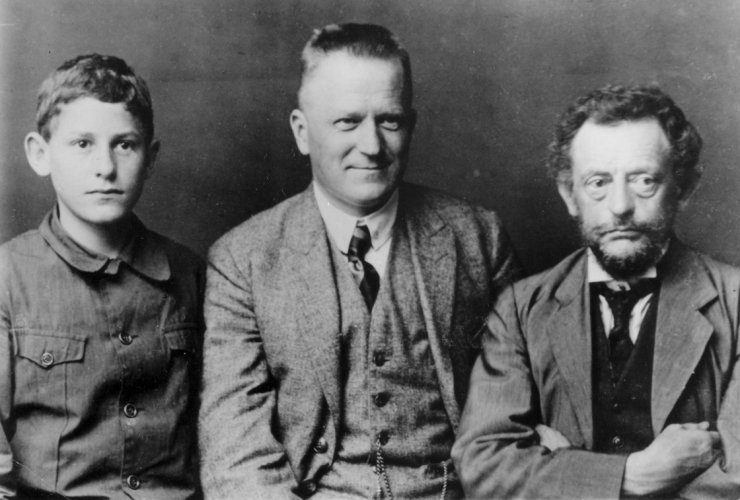
1923
Weakened by depression and his chronic heart condition, Barlach increasingly turns to literary work and completes his fifth play The Flood. He also makes lithographs for poems by Goethe.
1924
The Flood receives its first performance in Stuttgart. Barlach is awarded the Kleist Prize. He becomes acquainted with Bernhard and Marga Böhmer, who have settled in Güstrow.
1925
Barlach works on the play The Blue Boll and woodcuts for Schiller’s Ode to Joy. He is made an honorary member of the Academy of Visual Arts in Munich. Travels through southern Germany. Creates The Dreamer and *The Ascetic.
1926
Paul Cassirer kills himself. Exhibition of wooden sculptures at the Salon Cassirer and participation in the International Art Exhibition in Dresden. The Blue Boll is premiered in Stuttgart. Barlach turns down an appointment to the Weimar Art Academy. Sketches for a monument in Güstrow Cathedral and participation in a competition for a Beethoven memorial in Berlin. Moves his studio into a former garage. Love affair with Marga Böhmer, who divorces her husband in 1927. Barlach moves into the Böhmer’s house on the Heidberg outside Güstrow. Bernhard Böhmer becomes Barlach’s assistant and secretary and deals with the sale of his works. Barlach carves the wooden sculptures *The Reunion and *Death in Life.
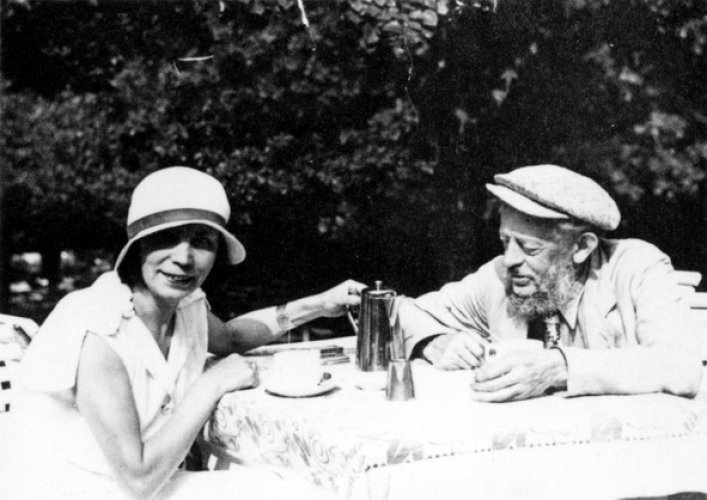
1927
Start of the ‘great working day’ – from now until 1932 Barlach designs and executes numerous monumental works for public spaces: the Güstrow Memorial (1927), the Spiritual Warrior in Kiel (1928), the Magdeburg Memorial (1929), the Hamburg Memorial (1931), and the Communion of Saints in Lübeck (1930–32). Barlach takes a cure in Bad Kissingen because of heart trouble. He writes down his autobiography A Self-told Life. Barlach begins the play The Count of Ratzeburg, which he works on until 1932.
1928
Installation of the bronze Spiritual Warrior in Kiel. The Foundling receives its first performance in Königsberg. Negotiations about a commission for a memorial in Malchin; Barlach’s designs are later rejected. Nationalist circles begin massive smear campaigns in reaction to the memorials in Güstrow and Kiel. Barlach works on the Magdeburg Memorial and completes *The Singing Man.
1929
Barlach publicly defends himself against attacks from the Steel Helmet league and other reactionary associations. First performance of the play The Good Time in Gera. Carl Georg Heise, director of the Lübeck Museum, commissions sixteen facade figures for the Church of St. Catherine in Lübeck – the Communion of Saints.
1930
The first figure for Lübeck is The Beggar. Barlach is invited to take part in the competition for the design of a memorial for the Rathausmarkt square in Hamburg; through the intervention of Fritz Schumacher, director of public works, he is later asked to provide a relief. Ludwig Katzenellenbogen – after Paul Cassirer the second husband of Tilla Durieux – commissions Barlach to realise the figural series *Frieze of the Listeners (already designed for the Beethoven memorial) in wood. Contract with the art dealer Alfred Flechtheim for twenty bronzes to be cast from plaster models by the Noack Foundry in Berlin-Friedenau. Meets Aristide Maillol in Berlin. Exhibitions celebrating his 60th birthday in the Prussian Academy of Arts in Berlin, the Folkwang Museum in Essen, the Kunsthalle zu Kiel and the Galerie Flechtheim. Increasing right-wing extremist defamation. Creation of *The Doubter.
1931
Moves into a new residential studio on the Heidberg near near Güstrow. Works on the Hamburg Memorial and on a tomb for Prince Reuß in Gera. For Lübeck he creates *Woman in the Wind and *The Singer; Barlach also completes *Christ Teaching and various *Masks of Christ. Ludwig Katzenellenbogen is plunged into a financial crisis and discontinues his payments for the *Frieze of the Listeners. Exhibitions in the Hamburger Kunstalle and the Kestner-Gesellschaft in Hannover.
1932
Barlach has to give up work on the Communion of Saints in Lübeck because no new donors can be found. Financial hardship and National Socialist propaganda make things very difficult for him. Designs for a memorial in Stralsund and work on *Hunger Group and *Monks Reading III. Special presentation at the autumn exhibition of the Prussian Academy of Arts in Berlin with nine sculptures and eleven drawings.
1933
Radio broadcast Künstler zur Zeit [Artists Now], a plea for freedom of thought and artistic expression. Barlach becomes a Knight of the Order Pour le Merité (civil class) and considers resigning from the Prussian Academy of Arts on the exclusion of Käthe Kollwitz and Heinrich Mann. He withdraws his designs for the memorial in Stralsund. In Magdeburg the cathedral council petitions for the removal of the memorial. Creation of *The Thirsty Man. Annulment of the contract for *Frieze of the Listeners, for which only three figures have been completed: *The Wanderer, *The Dancer and *The Dreamer.
1934
Exhibition at the Kunsthalle Bern. The Magdeburg Memorial is dismantled. Final performance of The Blue Boll in the Altonaer Theater. The Bremen-based painter Hugo Körtzinger and the Hamburg-based factory owner Hermann F. Reemtsma visit Barlach in Güstrow. Reemtsma purchases the wooden sculpture *The Ascetic and commissions him to continue the work on the *Frieze of the Listeners. Barlach’s situation becomes more stable. Creation of *The Flame.
1935
The wooden sculpture *The Reunion is removed from the permanent collection of the Landesmuseum Schwerin. After the successful premiere of The Genuine Sedemunds in the Altonaer Theater the play is dropped after five performances. The book Zeichnungen von Ernst Barlach [Drawings by Ernst Barlach], with fifty-six reproductions and an introduction by Paul Fechter, is published by Reinhard Piper in Munich. Intensive work on *Frieze of the Listeners, which is completed in October. Simultaneous creation of *Mother and Child.
1936
Barlach is made an honorary member of the Vienna Secession and the Association of Austrian Sculptors. He fails to realise a gravestone for Theoder Däubler due to the opposition of state institutions. The book Zeichnungen von Ernst Barlach is seized by the Bavarian police on the order of the Ministry of Propaganda. Works by Barlach, Wilhelm Lehmbruck and Käthe Kollwitz are removed from the anniversary exhibition of the Prussian Academy of Arts. Barlach works on the novel The Stolen Moon and the sculptures The Flute Player and *The Reader. Private publication by Hermann F. Reemtsma of a book on the *Frieze of the Listeners with a text by Hugo Körtzinger.
1937
Barlach’s health deteriorates. The bronze The Reunion and the book Zeichnungen von Ernst Barlach are shown in the National Socialist propaganda exhibition “Degenerate Art”. 381 works by Barlach are removed from German museums. Dismantling of the Spiritual Warrior in Kiel and the memorial in Güstrow Cathedral (melted down in 1941). Barlach is forced to resign from the Prussian Academy of Arts in Berlin. He is temporarily disbarred from exhibiting and threatened with a permanent occupational ban. He works on The Bad Year, *Old Woman Laughing and *Freezing Old Woman. The painter Leo von König and Ernst Barlach, colleagues from the time of the Berlin Secession, do each other’s portraits.
1938
Public announcement of the decision to remove Barlach’s relief from the Rathausmarkt in Hamburg (demolition in February 1939). In September Barlach enters the private hospital St. Georg in Rostock. Ernst Barlach dies on 24 October. His funeral service takes place on 27 October in the Güstrow studio; among the mourners are Carl Georg Heise, Hugo Körtzinger, Georg Kolbe, Käthe Kollwitz, Gerhard Marcks, Hermann F. Reemtsma, Richard Scheibe and Karl Schmidt-Rottluff. According to his wishes Barlach is buried in Ratzeburg on 28 October.
